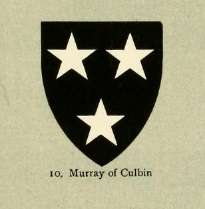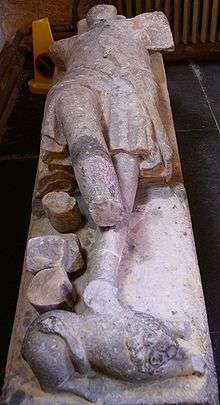Richard de Moravia

Richard de Moravia of Culbin or of Cubyn,[2] was a Scottish nobleman famed for his victory over the Vikings at the Battle of Embo which took place in Sutherland, Scotland sometime between 1260 and 1270.[3]
Origins
Richard de Moravia was either the cousin,[4][5] or nephew,[5] of Hugh or Hugo de Moravia, also known as Hugh Freskin,[5] who was the first Lord of Sutherland and whose son was William de Moravia, 1st Earl of Sutherland (d.1284).[5][4] Richard's brother was Gilbert de Moravia (d.1245) who was Bishop of Caithness.[2][5]
Castle and lands
Richard de Moravia received from his elder brother, Gilbert, all of the lands that Gilbert had received from Hugo Freskyn,[2] (also recorded as Hugo de Moravia) and the charter was confirmed by Alexander II of Scotland.[2] Richard was also given Skelbo Castle by his brother Gilbert in 1235.[6]
Battle of Embo

William, Earl of Sutherland asked Richard de Moravia to engage a party of Danes (Vikings) who had landed at Littleferry, Sutherland until the Earl could come to his aid with a stronger force.[6] The plan worked and the Danes were routed by the arrival of the Earl.[6][4] However, Richard was killed during the battle.[6] The Earl then arranged for Richard's body to be interred in Dornoch Cathedral and his damaged sarcophagus can still be seen there today.[6] This was known as the Battle of Embo and took place sometime between 1260 and 1270.[6][3]
Family and descendants
Richard de Moravia had a son called Alan; whose son was Reginald; whose son was Gilbert.[2] Gilbert married Eustachia, daughter of Kenneth de Moravia, 4th Earl of Sutherland.[2] Their son was Walter whose daughter and heiress was Egidia de Moravia who carried the estates of Cubyn (Culbin) and Skelbol (Skelbo) into the Kinnaird family.[2]
Richard de Moravia is also believed to have been the ancestor of the Murray of Aberscross family in Sutherland.[4] The surname de Moravia meaning "of Moray" or "of Murray".[7]
The Murray of Culbin coat of arms is recorded as Sable, three stars argent.[1]
References
- 1 2 Johnston, G. Harvey (George Harvey), 1860-1921. (1910). The Heraldry of the Murrays : with notes on all the males of the family, descriptions of the arms, plates and pedigrees pp. 104 - 106: Quoting: Forman's MS, Lyon Office, c. 1566.
- 1 2 3 4 5 6 7 ’’Registrum Episcopatus Moraviensis, Publications, Issue 58’’. (1837). Scotland. p. Xxxiii.
- 1 2 ’’Sir Richard de Moravia’’ findagrave.com. Retrieved February 11, 2018.
- 1 2 3 4 Early History of Clan Murray (Clann Mhoraidh) in New Scotland (Nova Scotia) chebucto.ns.ca. Retrieved February 11, 2018.
- 1 2 3 4 5 Rose, Mr D. Murray. "NOTES ON THE FAMILY OF DE MORAVIA, OR MORAY. Part 1". Electric Scotland. Electric Scotland. Retrieved February 11, 2018.
- 1 2 3 4 5 6 Norse Invaders historylinks.org.uk. Retrieved February 2, 2018.
- ↑ Sutherland, Malcolm. (1996). A Fighting Clan, Sutherland Officers: 1250 – 1850. p. 3. Avon Books. ISBN 1-897960-47-6.